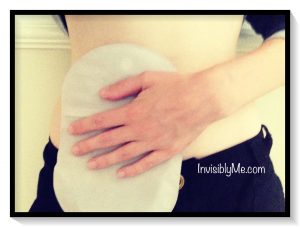When I had my ileostomy, I was told absolutely nothing about long term caution with lifting and pulling; hernias were never mentioned, I was just advised to be ‘careful’ for the first 2-3 months or so. Even the stoma nurses didn’t tell me anything until I asked them about it directly recently. I wish I knew then what I know now after learning more about safety when it comes to stomas. I’ve also done a short post on where you can order pants/support wear belts here.
… What’s A Hernia? …
Referred to as a parastomal hernia, this is where there’s weakness in a muscular wall of the abdomen gives way and results in some of the inside (ie. small bowel if you have a loop ileo) to bulge out. Whilst this happens internally, the bulge can usually be felt and seen on your tummy under the skin, and it may cause the stoma itself to protrude further than usual too.
Prevention is better than cure. Some hernias are very small and not problematic and may not require treatment. Others may get larger and more uncomfortable with time, and there’s a risk of further complications; in certain cases it may mean surgery to repair the hernia. Whilst the hernia may not hurt, if you suspect you may have one it’s important to speak to your stoma nurse or GP as soon as you can. You may notice increased pressure in the stoma area, but of course if it’s got to the point where you have severe pain, it’s causing you to be sick, or there’s no output, speak to someone ASAP or get checked in to A&E to be sure.
… Who’s At Risk? …
Simply put, a hernia can happen to anyone. Common sense suggests that those with weaker muscles in the abdomen may be more at risk. It’s been reported that a good proportion of hernias occur within the first two years of surgery.
The risk of a hernia and other complications is increased in the weeks and months following ostomy surgery as this directly affects the area. This is why you’re told to not lift anything heavy. It should be noted that this really applies to doing anything with force involving abdominal muscles needing to be used, including pushing or pulling (even a trolly load of shopping).
After those months, for the duration you’re an ostomate, be that a year or a lifetime, hernia prevention is still important. Having a stoma shouldn’t stop you from living and doing the things you’d like to do, it just means you need to apply a little caution.

… What Causes A Hernia? …
There’s no one cause, but there are some contributing factors to consider. For instance, anything that puts a strain on the abdominal muscles, lifting, sneezing and coughing. Over time, the area around the stoma can become gradually weaker, so developing a hernia can also be a gradual process.
… What’s The Difference Between A Hernia & A Prolapse? …
A prolapse is the stoma jutting out further than usual, but doesn’t involve the bulge within the tummy and internal abdominal wall. It can make the stoma look much bigger, and it can be scary to see such a change in size/shape. Whilst some of the contributing causes may be similar to those of a hernia (ie. coughing or lifting), a hernia involves the internal muscles as the root of the problem.
… Prevention Is Better Than Cure …
- Be more aware when going about activities that involve your abdominal muscles. Of course, we use them all the time without realising it, but try to tune in to your tummy a bit more and how your muscles are used on a daily basis.
- Support your stoma and the surrounding tummy area with your hand pressed flat, or a pillow/cushion if you have one at hand, when sneezing or coughing.
- Avoid lifting, pulling or pushing excessively heavy things where possible.
- Check out the lower level support underwear, bands and wraps for casual use.
- If undertaking activities you know will involve some strain, such as bowling, use a higher level support band.
- The muscles to the side of your waist are stronger and bending sideways may put less pressure the stomal area than bending forwards where possible.
- When lifting, try to keep the object closer to you, keep your feet apart, back straight and bend at the knees.
- Stay active – this seemed a bit counter intuitive to me, as advice suggests developing your abdominal muscles at the same time as not using them! Speak to your stoma nurse or surgeon first, and perhaps start with light exercises, such as walking or gentle yoga. Always make sure to get any stomach exercises confirmed from a specialist.
This may all sound really scary – it certainly does to me! I also don’t want to be avoiding doing anything for fear of using my tummy muscles, be hyper aware every day of the smallest movements I make, or feel I have to constantly wear a support belt out of sheer fear of developing a hernia.
I’m supporting my tum more often, and trying to remember to do it when coughing and sneezing, and I’m finding it’s becoming more habitual and second nature to do so already. I’ve had a fitting for a neat, stretchy support belt; in a few weeks’ time I may push the boat out and go bowling (fortunately, I’m a bit of a weakling and use the lighter balls anyway!).
A hernia may happen. It may not, ever. It’s just about being aware of the risks, and applying some caution where necessary.

